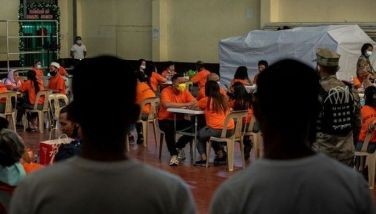DOST pushes for forensic use of DNA testing
September 9, 2002 | 12:00am
Crime-fighting in the country is expected to be revolutionized as efforts to make use of forensic DNA analysis are intensified.
DNA stands for deoxyribonucleic acid, the molecule inside every individual’s cells that carries genetic information which in turn is passed from one generation to another.
"The greatest role of DNA analysis lies in its capability to accelerate criminal investigations by identifying perpetrators and excluding innocent individuals at the onset of the criminal investigation," said the Department of Science and Technology-Philippine Council for Advanced Science and Technology Research and Development (DOST-PCASTRD).
It added: "With the aid of DNA analysis, a fair and swift administration of the justice system in the country can be expected."
In the Philippines, a group of researchers from the Natural Sciences Research Institute (NSRI) at the University of the Philippines Diliman (UPD) are gearing their efforts in making use of forensic DNA analysis, a cutting-edge technology that the country’s law enforcement agencies can use in bringing criminals to justice and to exonerate the innocent.
Funded by PCASTRD under its Bioinformatics Research and Development Program and led by Dr. Ma. Corazon de Ungria, the NSRI project aims to develop and validate forensic DNA methods for direct applications in casework.
DNA typing or DNA profiling is a procedure wherein DNA extracted from a biological sample obtained from an individual is analyzed and compared with DNA profile obtained from evidentiary samples.
De Ungria explained that the strength of forensic DNA analysis lies in the properties of DNA molecule that includes its capacity to discriminate between people, except for identical twins. Also, the DNA molecules can remain intact for centuries and even survive beyond death.
As proof of DNA’s molecular stability, the team of De Ungria was able to identify 18 out of the 21 exhumed bodies of Asosacion de Damas Filipinas Settlement victims that were burned in December 1998.
Aside from the potential of DNA analysis in identifying mass disaster victims, it can also aid in determining paternity.
This is based on the fact that the DNA of a child has two copies (one from the mother and the other from the father). The DNA of the mother, the alleged father, and the child are analyzed to establish paternity. The paternal DNA copy should then be observed in the alleged father.
DNA stands for deoxyribonucleic acid, the molecule inside every individual’s cells that carries genetic information which in turn is passed from one generation to another.
"The greatest role of DNA analysis lies in its capability to accelerate criminal investigations by identifying perpetrators and excluding innocent individuals at the onset of the criminal investigation," said the Department of Science and Technology-Philippine Council for Advanced Science and Technology Research and Development (DOST-PCASTRD).
It added: "With the aid of DNA analysis, a fair and swift administration of the justice system in the country can be expected."
In the Philippines, a group of researchers from the Natural Sciences Research Institute (NSRI) at the University of the Philippines Diliman (UPD) are gearing their efforts in making use of forensic DNA analysis, a cutting-edge technology that the country’s law enforcement agencies can use in bringing criminals to justice and to exonerate the innocent.
Funded by PCASTRD under its Bioinformatics Research and Development Program and led by Dr. Ma. Corazon de Ungria, the NSRI project aims to develop and validate forensic DNA methods for direct applications in casework.
DNA typing or DNA profiling is a procedure wherein DNA extracted from a biological sample obtained from an individual is analyzed and compared with DNA profile obtained from evidentiary samples.
De Ungria explained that the strength of forensic DNA analysis lies in the properties of DNA molecule that includes its capacity to discriminate between people, except for identical twins. Also, the DNA molecules can remain intact for centuries and even survive beyond death.
As proof of DNA’s molecular stability, the team of De Ungria was able to identify 18 out of the 21 exhumed bodies of Asosacion de Damas Filipinas Settlement victims that were burned in December 1998.
Aside from the potential of DNA analysis in identifying mass disaster victims, it can also aid in determining paternity.
This is based on the fact that the DNA of a child has two copies (one from the mother and the other from the father). The DNA of the mother, the alleged father, and the child are analyzed to establish paternity. The paternal DNA copy should then be observed in the alleged father.
BrandSpace Articles
<
>
- Latest
- Trending
Trending
Latest




























